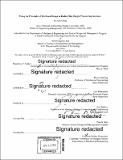Using the principles of set-based design to realize ship design process improvement
Author(s)
Genta, John (John Anthony)
DownloadFull printable version (18.14Mb)
Alternative title
Using the principles of SBD to realize ship design process improvement
Other Contributors
System Design and Management Program.
Advisor
Warren Seering, Eric Rebentisch and Joe Harbour.
Terms of use
Metadata
Show full item recordAbstract
Set-based design (SBD) is a relatively new complex product development method. Its use has been well researched in the automotive and aerospace industries and, although it requires an upfront investment in resources, it has been shown to reduce design cycle time, later stage rework, total ownership cost, and improve design knowledge capture. The current fiscal environment of the U.S. Government has obligated the Department of Defense to challenge each service to "do more, without more" by finding efficiencies. Since 2005, the U.S. Navy has self-identified ship design as a process improvement priority and embarked in design tool and policy changes which resulted in the "Two Pass / Six Gate" process in 2008. Subsequent U.S. Navy ship design and acquisition actions have presented an opportunity to research and analyze the amenability of SBD, and its proposed benefits, with the U.S. Navy's Two Pass / Six Gate process to realize the efficiencies sought by acquisition executives. The results of this analysis identified that Gates 2 (Analysis of Alternatives) and 3 (Capability Development Document) have the most amenability to the principles and benefits of SBD. An Analysis of Feasibility is provided as an alternative to the current Gate 2 and 3 ship design processes. Executing Gate 2 and 3 ship design activities using the set-based Analysis of Feasibility process produces preferred Cost vs Capability trade-off results while reducing design cycle time and cost. Specific policy recommendations for the Assistant Secretary of the Navy (Research, Development and Acquisition) are provided to decree replacement of the current Analysis of Alternatives with the Analysis of Feasibility.
Description
Thesis: Nav. E., Massachusetts Institute of Technology, Department of Mechanical Engineering, 2016. Thesis: S.M. in Engineering and Management, Massachusetts Institute of Technology, School of Engineering, Institute for Data, Systems, and Society, System Design and Management Program, 2016. Cataloged from PDF version of thesis. Includes bibliographical references (pages 143-154).
Date issued
2016Department
System Design and Management Program.; Massachusetts Institute of Technology. Department of Mechanical Engineering; Massachusetts Institute of Technology. Engineering Systems Division; Massachusetts Institute of Technology. Institute for Data, Systems, and SocietyPublisher
Massachusetts Institute of Technology
Keywords
Institute for Data, Systems, and Society., Mechanical Engineering., Engineering Systems Division., System Design and Management Program.